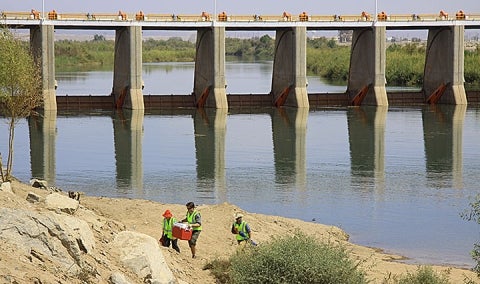Note: Yale School of the Environment (YSE) was formerly known as the Yale School of Forestry & Environmental Studies (F&ES). News articles and events posted prior to July 1, 2020 refer to the School's name at that time.
 Researchers collect water samples.
Researchers collect water samples.
Earlier this spring, for the first time in years, operators lifted the gates of the Morelos Dam at the U.S.-Mexico border, allowing a rare pulse of water to flow into the parched, final stretches of the Colorado River Delta. The release, which was part of an international river agreement, was seen as a small victory for conservationists who are hoping to restore the delta's wetlands.
For researchers at the Yale School of Forestry & Environmental Studies (F&ES), it also provided a rare opportunity.
Just days before the release, a team from F&ES and the University of Florida received a $80,000 Rapid Response Research (RAPID) grant from the National Science Foundation to collect valuable water chemistry measurements from the newly flooded delta in the aftermath of the release.
Specifically, they were looking to assess how the restoration of water affects the carbon cycling in the long-dry river delta, once one of the planet’s great desert estuaries, and how the release of carbon stored in that soil impacts the ecosystem after it’s introduced to the water.
The research team leaders included Peter Raymond, a professor of ecosystem ecology at F&ES, and Thomas Bianchi, a professor of geological sciences at the University of Florida.
For researchers at the Yale School of Forestry & Environmental Studies (F&ES), it also provided a rare opportunity.
Just days before the release, a team from F&ES and the University of Florida received a $80,000 Rapid Response Research (RAPID) grant from the National Science Foundation to collect valuable water chemistry measurements from the newly flooded delta in the aftermath of the release.
Specifically, they were looking to assess how the restoration of water affects the carbon cycling in the long-dry river delta, once one of the planet’s great desert estuaries, and how the release of carbon stored in that soil impacts the ecosystem after it’s introduced to the water.
The research team leaders included Peter Raymond, a professor of ecosystem ecology at F&ES, and Thomas Bianchi, a professor of geological sciences at the University of Florida.
To have everything compressed so tightly, we had to devote ourselves to this for that short amount of time and forget everything else. Because there wasn’t much room for mistakes.
“There are a lot of these dry flood plains around the world because of water impoundments,” said David Butman, a postdoctoral associate at F&ES and principal investigator. “So if you have the opportunity to re-flood one these systems, you can determine if there is a capacity waiting to provide energy and a boost to the ecosystems again.”
For Butman, who was in charge of collecting the field data, the study was an unlikely opportunity to perform research on the fly. Just days after receiving official notification of the grant, he was on a flight to Arizona, where he led a small team collecting data from five sampling sites along the river, just over the Mexican border.
“This all started to come together in early March,” he said, “and we were already sampling by the middle to the end of March. It’s amazing that it worked out.”
The researchers concentrated on a “pristine” stretch of the river running along the U.S.-Mexico border. (Before the water was released, Butman says, much of that sandy terrain had been used previously for, among other activities, dune buggy racing.)
After testing the samples collected from different stretches of the river, they hope to determine how much of that carbon has been stored in the soil, and the extent to which it can reinvigorate the river ecosystem again.
“I had never experienced anything like this,” Butman said. “To have everything compressed so tightly, we had to devote ourselves to this for that short amount of time and forget everything else. Because there wasn’t much room for mistakes.”
For Butman, who was in charge of collecting the field data, the study was an unlikely opportunity to perform research on the fly. Just days after receiving official notification of the grant, he was on a flight to Arizona, where he led a small team collecting data from five sampling sites along the river, just over the Mexican border.
“This all started to come together in early March,” he said, “and we were already sampling by the middle to the end of March. It’s amazing that it worked out.”
The researchers concentrated on a “pristine” stretch of the river running along the U.S.-Mexico border. (Before the water was released, Butman says, much of that sandy terrain had been used previously for, among other activities, dune buggy racing.)
After testing the samples collected from different stretches of the river, they hope to determine how much of that carbon has been stored in the soil, and the extent to which it can reinvigorate the river ecosystem again.
“I had never experienced anything like this,” Butman said. “To have everything compressed so tightly, we had to devote ourselves to this for that short amount of time and forget everything else. Because there wasn’t much room for mistakes.”
– Kevin Dennehy kevin.dennehy@yale.edu 203 436-4842
Published
May 13, 2014